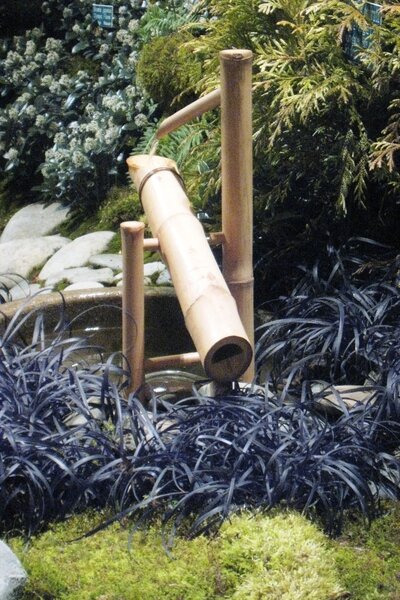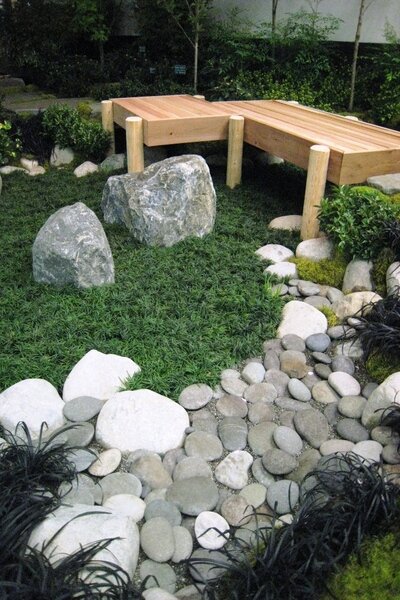A small water feature makes a big impact with the right plants
Loading...
Do you ever long for a large water feature in your landscape? But considerations of money, time, maintenance, logistics or all of the above keep that from happening?
If you find yourself confined to thinking smaller when it comes to water, take a tip from the design of Roger Williams, Phil Wood, and Bob Lilly.
These talented gentlemen were responsible for the Washington Arboretum Foundation’s display at Seattle’s 2011 Northwest Flower & Garden Show. Winning both a gold and the Pacific Horticulture Magazine award, this clever garden celebrated the Arboretum’s 50th anniversary of its own Japanese Garden.
My favorite part of the display was how the designers handled water. They combined a small water feature with a large planting that mimics water.
A modest pool with a bamboo clacker [see first photo at left] gives the needed sound and sparkle. Then dwarf green mondo grass (Ophiopogon japonicus) steps in as a water substitute.
The low-growing lily turf grasses spill down from the real water and flow under the bridge [see second photo at left; click on the arrow at the right base of the first photo] to form a pond. Large rocks rise up from the planting, like islands in a grassy sea. Rounded river cobbles form a beach on the edge.
What makes it work
Designers view water as a calming negative space. “Negative space can be so important in a garden,” says Mr. Wood, a landscape architect, “especially if it’s large enough to create a foil for planting complexity around it.”
In this case, the dwarf mondo grass forms the negative space, acting like water and giving the illusion of a flat surface. All the pool plant material grows at the same height.
If you want to plan your own "herbaceous pond," look for plants with uniformity of growth.
Positioned on the banks of what the designers call the “metaphorical pool,” are evergreen shrubs Sarcococca rusicifolia (fragrant sweet box) and taller black mondo grasses (Ophiopogon planiscapus ‘nigrescens’). Echoing its cousin, the dwarf lily turf in the pool, the black mondo grass stands out with bolder dark color and a more upright form.
For your own pond edges, choose strongly architectural plants that will supply the contrasting complexity to the faux water’s calm surface.
Foliage color counts. For the show pool, designers Williams, Woods, and Lily chose darker rather than lighter vegetation. The densely planted deep green grasses reinforce the idea of water.
When you are considering what you could plant, look for evergreens whose strength is foliage, not flowers.
How to plant like water
While this restrained color palette is suitable to the arboretum’s Japanese theme, for your own “water,” you could put together two contrasting color choices.
Swirls of lighter and darker plantings might mimic the motion of water, with highlighted ripples, and deeper-colored wave troughs. This could be particularly effective when planted around rocks. You could delineate the moving water with color as it crests around the barrier.
Finally, study how water moves in nature. It careens off steep banks. It deposits beaches in calm spots.
When you plan your design, consider where water wants to go and where it might be already on your own property. Perhaps you can combine a small water feature with a rain garden that imitates a stream and pond and place it at an existing low point or wet area.
-----
Mary-Kate Mackey blogs regularly about water in the garden for Diggin' It. She is co-author of “Sunset’s Secret Gardens — 153 Design Tips from the Pros” and contributor to the 'Sunset Western Garden Book,' writes a monthly column for the Hartley Greenhouse webpage and numerous articles for Fine Gardening, Sunset, and other magazines. She teaches at the University of Oregon’s School of Journalism & Communication. To read more by Mary-Kate, click here.






